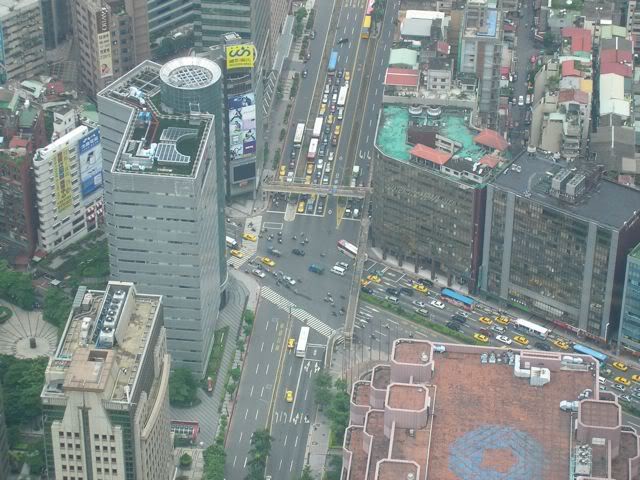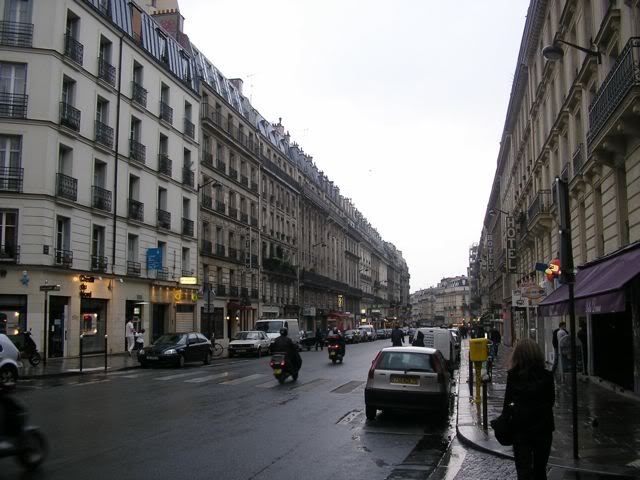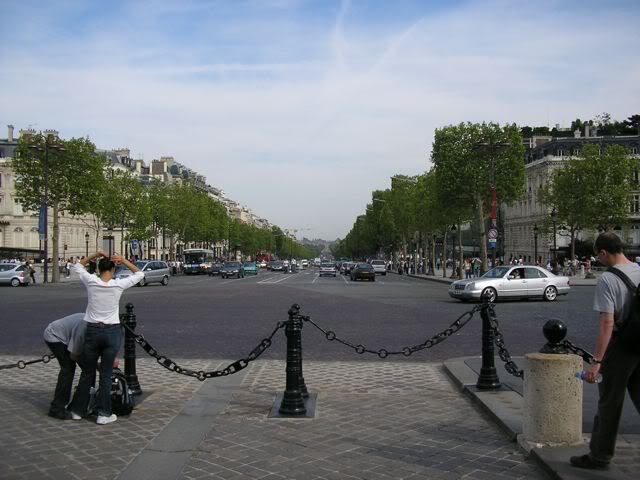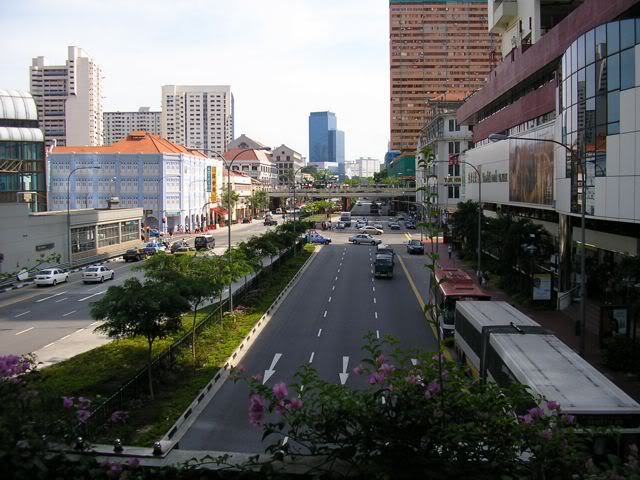Earlier this week, Governor Gregoire threatened she will simply tear down the Alaska Way Viaduct by 2012, if it is not replaced before that.
While Seattlites have been debating the merits of her threat (and whether she will even be in office in 2012), I found another part of her statements somewhat puzzling….and they need some correction lest Rentonites somehow take them at face value.
The Governor is quoted as saying:
“We really are fundamentally not efficient and effective now. Our offramps from I-5 are not efficient to the flow of traffic. What international city do we know of that would have two-way traffic in downtown? What international city do we know of that would have street parking in the middle of downtown?”
If I understand correctly, the governor is implying we need to get rid of Seattle’s remaining two-way street traffic, and on-street parking, to make Seattle an international city.
Knowing this did not seem right, I made a quick run-through of a few of travel photos:

Taipei (from Taipei 101, tallest building in the world)

Tokyo

Paris

Paris… (Champs Elysees)

Singapore
I could have published photo’s from many, many other international city that show two-way traffic and street parking in downtown.
I don’t think that going to one-way streets and getting rid of parking should be the answer to our traffic woes, in Seattle or in Renton.
I also don’t think the Governor should tear down the viaduct without a good plan in place… I don’t want Seattle to jump in front of I-405 in the funding race just because the Governor says “It’s coming down in 2012. I’m taking it down — the middle”.
Last updated January 3, 2008 11:28 p.m. PT
Gregoire: ‘Watch me’ tear down the viaduct
Governor tells the city she won’t let issue be pushed to back burner
By CHRIS McGANN
P-I CAPITOL CORRESPONDENT
OLYMPIA– With or without Seattle’s approval, the state will tear down the earthquake-damaged Alaskan Way Viaduct in 2012, Gov. Chris Gregoire said Thursday.
“It’s coming down in 2012. I’m taking it down — the middle,” she said, referring to the elevated portion of the span that runs roughly from Battery Street Tunnel to Pioneer Square, which has been the most vexing and controversial piece of the transportation puzzle.
“That’s the timeline. I’m not going to fudge on it. And if we don’t have some alternative by then, boy are we going to have a mess on our hands because it’s coming down.”
Asked if she, as governor, could trump the state’s largest city and county and unilaterally tear down a highway that carries more than 100,000 vehicles a day through the heart of Seattle, Gregoire said:
“Yeah, watch me.”
The governor set a hard deadline after a tortured and unsuccessful attempt to resolve the issue last year. At that time Seattle, King County and the state fought and floundered in their attempts to produce a viable option for replacing or rebuilding the viaduct.
Instead of a new $2.8 billion elevated highway similar to the current viaduct the state wanted, Seattle Mayor Greg Nickels fought for a more expensive tunnel and King County Executive Ron Sims wanted a street-level solution that would have included much more transit.
Last year Gregoire twisted arms and issued her recommendation but ultimately deferred the decision to Seattle voters, who rejected both a proposed elevated rebuild and a more expensive tunnel along the waterfront. The surface option was not on the ballot.
In the end, elected leaders agreed to a truce and opted to begin demolition and utility relocation on the south end of the roadway.
That gave everyone until 2012 to agree about how to replace the double-decker section through the heart of the city.
Now Gregoire said she’s not letting the issue get pushed to a political back burner.
Seattle Deputy Mayor Tim Ceis said setting an inflexible deadline is unrealistic.
“This is not just an issue for the city of Seattle to ensure that the system functions when it comes down, this is an issue for the entire state of Washington, because this is the economic center for the state,” he said.
If the statement was intended to be a threat, Ceis said, it would be out of character to Gregoire.
“I find it hard to believe that she is issuing a threat right now because we are all working so well together. … It’s everybody’s objective to get the viaduct down as soon as is possible and practical. But in order to do that, you have to ensure that projects have been funded and completed that allow the transportation system to continue to function if you cut off that corridor.”
He said the city and the state are making good progress toward crafting a workable solution the people will agree on.
“No matter what, the state has to be a constructive partner in this project,” Ceis said. “The state has the funding and we need to be able to make those fixes to the rest of the system in order for the viaduct to come down by 2012.”
Ceis said the timeline was not, in itself, impossible, “but it’s going to take a real push by all parties involved.”
As for the sticky question of how to pay for the project, Gregoire said the state would keep its commitment to provide $2.8 billion. Any more would have to come from other sources.
Although she plans to team up with other governors to appeal to the federal government for increased investments in state infrastructure projects, Gregoire said that money would not be secured in time for the viaduct replacement.
Sims applauded the governor’s hard deadline and her openness to addressing the problem with a much more comprehensive solution.
“The viaduct has to come down. It’s not safe,” Sims said. “I support (Gregoire’s) position on that. It is a tough decision to make … but it’s the smart thing to do.”
In the past, Gregoire opposed a surface option, but in recent months she has said she’s now open to the idea.
In last year’s debate, Speaker of the House Frank Chopp, D-Seattle, was unbending about his desire to rebuild an elevated viaduct.
“I’m comfortable with her statement,” he said. “That project has got to get resolved; it cannot just go on forever.”
He said Gregoire had already made her deadline clear.
“I remember her telling me that a long time ago because obviously, it’s a safety issue,” he said.
As the discussion continues about a surface option, leaders are careful to explain they aren’t simply talking about a ground-level highway along the waterfront.
The viaduct traffic would have to be dispersed and otherwise addressed through a wide swath of Seattle.
“What Greg (Nickels) and Ron (Sims) and I have talked about is: ‘Let’s stop thinking about replacement of the Alaska Way Viaduct and start thinking about how do we do transportation in all of Seattle from I-5 to the waterfront,’ ” Gregoire said.
“We really are fundamentally not efficient and effective now. Our offramps from I-5 are not efficient to the flow of traffic. What international city do we know of that would have two-way traffic in downtown? What international city do we know of that would have street parking in the middle of downtown?
“We have not stepped back, collectively … and said, ‘How can we make this a user-friendly, international city?’
“That’s why a ‘surface option’ is on the table now,” Gregoire said. “If we simply say replace the viaduct, and if that’s all we do, the surface option won’t work. I still stand by that. I’ve looked at it, the ramifications to the waterfront are terrible. We won’t have any legitimate freight mobility. … The surface option works only (and I don’t know if it does) but only if you look at the totality.”
P-I reporter Chris McGann can be reached at 360-943-3990 or chrismcgann@seattlepi.com.


I saw Rossi speak tonight. He is going to make congestion one of his issues. He looked and sounded great. He reminded us of Denis. Vote Rossi and give him a chance.
I ended up voting for him last time — the first R I had really ever voted for. I mostly don’t like one party controlling everything. If we aren’t going to be completely nonpartisan, there at least needs to be some type of check and balance system in place.
Not sure whether I’ll vote for him again. I kind of appreciate the on-the-job experience and learning that takes place, and understand that it really takes at least two terms to affect change.
I always operate from the standpoint that state government is going to be the least efficient, and most riddled with controversy and bureaucracy (see Margarita Prentice). County government is only slightly better. It’s only when you get to city government that we actually have the ability to be heard. Maybe that will change a bit if Marcie Maxwell gets elected to the state legislature — at least we’d have someone in Renton.